Amazon API: Exploring key interfaces
Amazon sellers utilize self-developed or third-party software solutions, such as AMALYTIX, to analyze data, manage inventory, or plan advertising campaigns on Amazon. To facilitate communication between these diverse programs and Amazon’s platform, Amazon provides corresponding interfaces, known as Application Programming Interfaces (APIs).
In the following sections, we will delve into the pivotal APIs available to merchants, enabling them to manage their activities on Amazon:
- The Marketplace Web Service API (MWS) for sellers,
- The Selling Partner API (SP) for both sellers and vendors, and
- The Amazon Advertising API (AA).
Amazon Marketplace Web Service (MWS API)
Amazon MWS, which stands for “Amazon Marketplace Web Service,” conceals one of Amazon’s initial interfaces developed for the Amazon Marketplace participants, the sellers. As the name suggests, this interface is exclusively available to sellers on the Amazon platform. Pure vendors, on the other hand, cannot utilize this interface.
The MWS interface essentially empowers you to perform nearly all the actions accessible through Seller Central.
To leverage this interface, you must initially generate an Authentication Token within Seller Central and integrate this token into the respective application. This token essentially functions as the password for the specific application, allowing it to access the MWS interface on behalf of the seller.
The MWS API provides the following endpoints for various functions:
- Feeds
- Finances
- Fulfillment Inbound Shipment
- Fulfillment Inventory
- Fulfillment Outbound Shipment
- Merchant Fulfillment
- Orders
- Products
- Recommendations
- Reports
- Sellers
- Shipment Invoicing
For reviewing the outcomes of individual reports and queries, Amazon offers the MWS Scratchpad webpage. This platform comprises a form that enables you to execute requests to the interface efficiently.
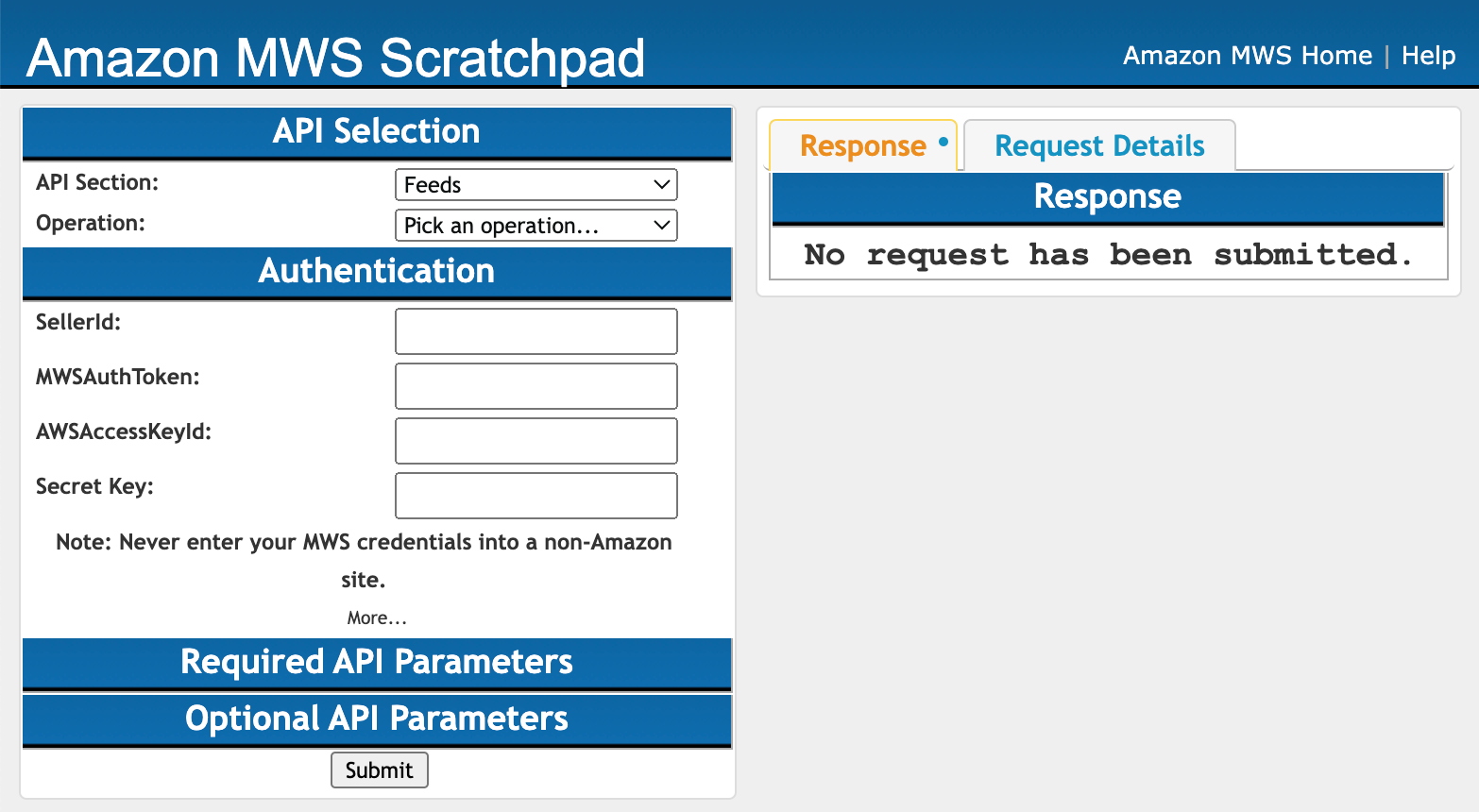
For instance, if you are limited to accessing orders from the past 60 days solely through Seller Central, you can utilize the MWS Scratchpad to retrieve orders retrospectively for up to a year.
You can access the complete documentation of the MWS interface right here →.
Amazon Selling Partner API (SP-API)
The Amazon Selling Partner API (SP-API) represents an evolution of the MWS API. It serves as an interface that enables selling partners on Amazon to programmatically access their data regarding listings, orders, payments, reports, and more. Amazon intentionally employs the term “selling partners,” encompassing not only sellers but also vendors, marking a significant expansion of the scope.
The SP-API offers the capability to develop customized automation for specific applications, such as:
- Regularly extracting order data and automatically emailing orders for certain products to your suppliers.
- Retrieving financial transactions to generate automated customer invoices, delivering them via email.
- Real-time price adjustments in response to the prevailing competitive landscape.
The SP-API encompasses all functionalities that were formerly accessible through Amazon MWS. Furthermore, in addition to the existing features, new selling partner APIs have been introduced, catering to Amazon vendor APIs for the first time. All operations are orchestrated through the same API control layer and follow the exact authorization mechanisms.
An additional departure from the MWS-API pertains to the authorization process for apps or developers. While with the MWS-API, you had to obtain a token from Amazon to unlock access, the authorization is now carried out within the specific application. You need to establish access from within the application to link your seller account with the Amazon SP API. In the case of Amalytix, this process appears as follows:
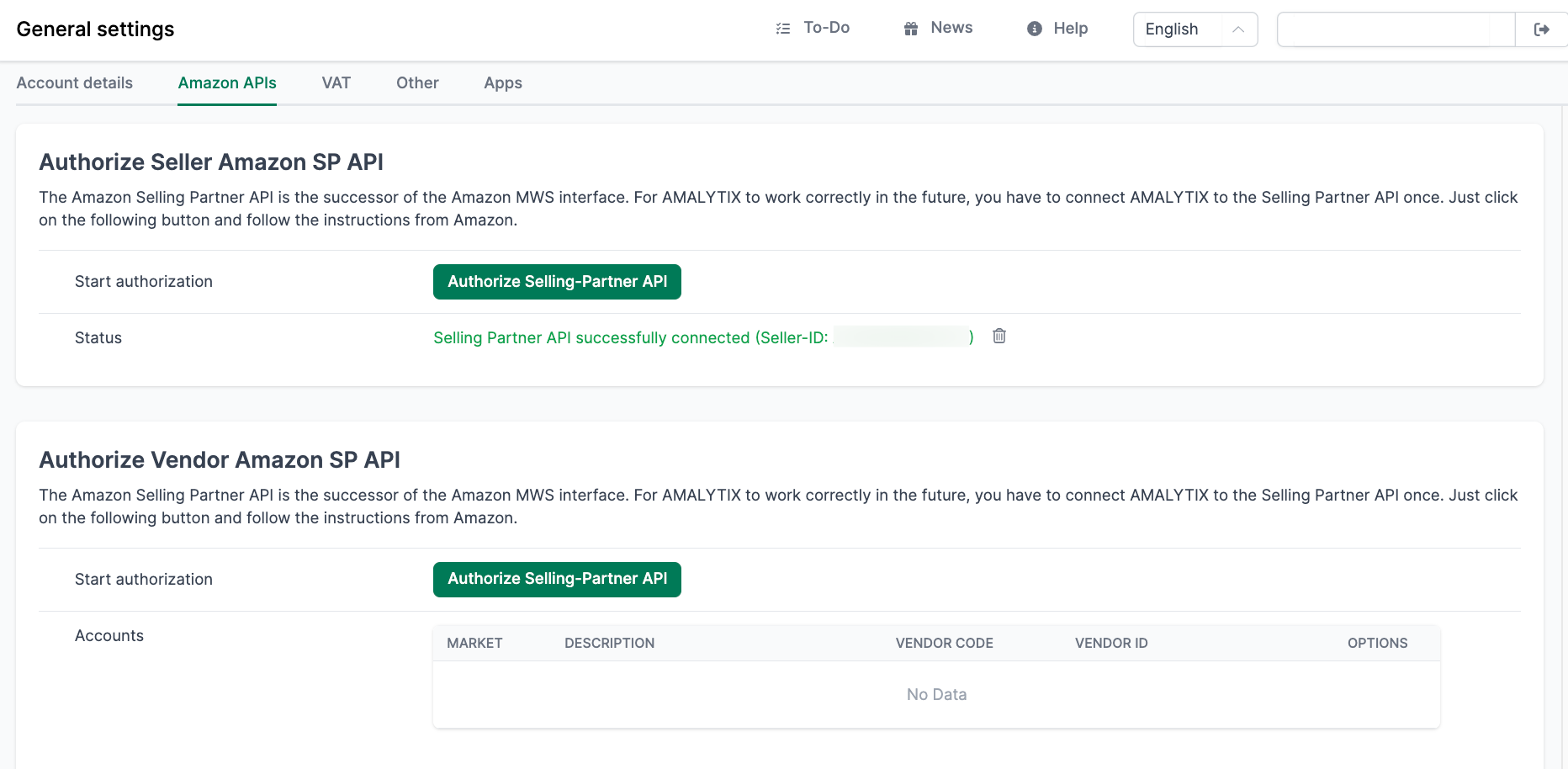
Upon logging into your seller account, you will be directed to the following page, where you can provide the final confirmation for granting access.
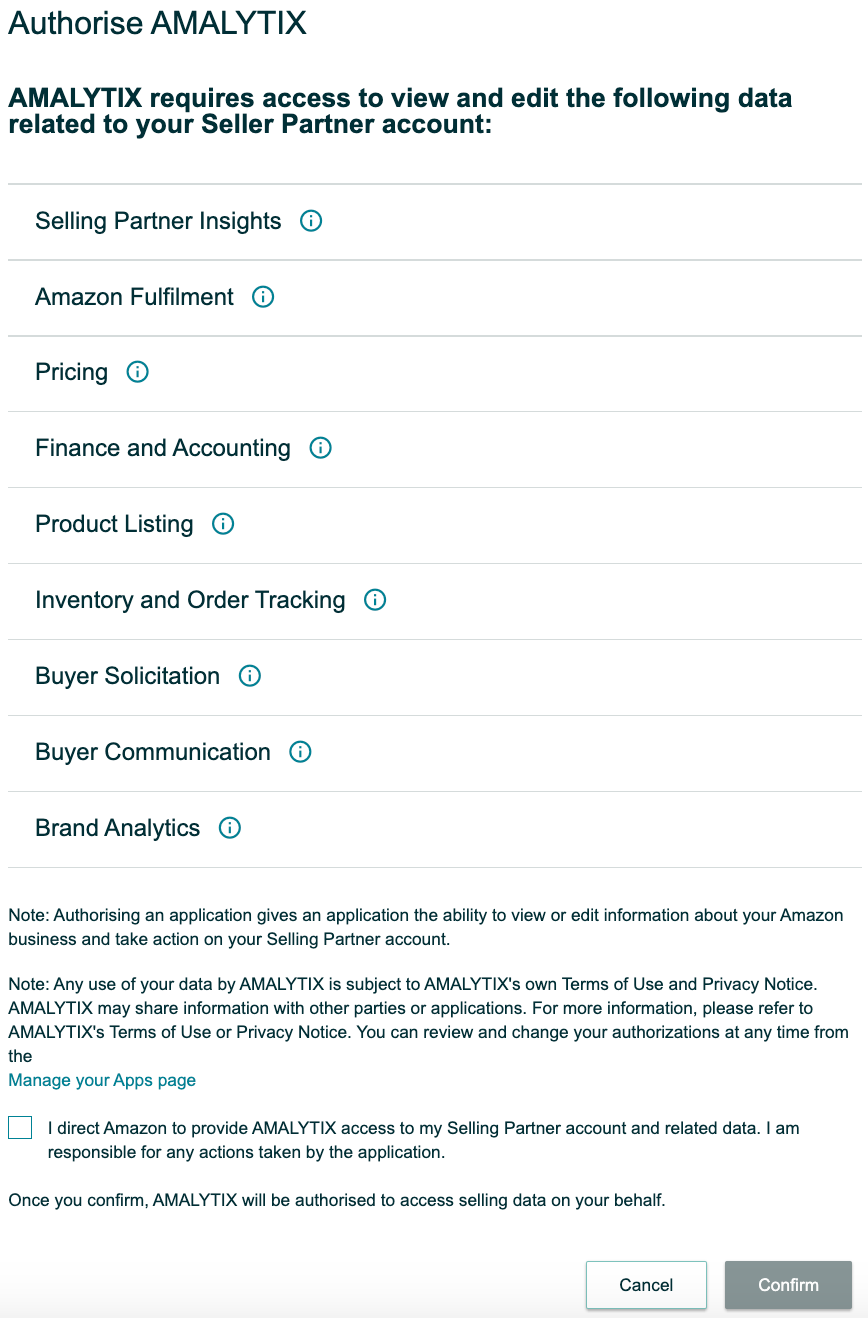
Subsequently, a connection is established between Amalytix and your Amazon seller account.
The SP-API introduces a “sandbox function,” allowing you to test changes before they go live.
Here’s an overview of several available SP interfaces:
| Name | Function |
|---|---|
| Reports | Provides various reports, such as financial transactions, orders, etc. |
| Finances | Lists all individual financial transactions, such as through orders |
| Fulfillment Inbound Shipment | Creation, updating, and management of shipments to Amazon |
| Subscriptions | Notifications about price changes on listings |
| Sellers | List of all marketplaces where the seller is active |
New and updated Selling Partner APIs:
| Name | Function |
|---|---|
| A-Plus Content | Creating and editing A+ content |
| Catalog items | Retrieving item details in the Amazon catalog |
| Product Pricing | Retrieving product prices and offer information |
| Shipping | Retrieving shipping services |
You can find additional APIs listed under “references” in the documentation.
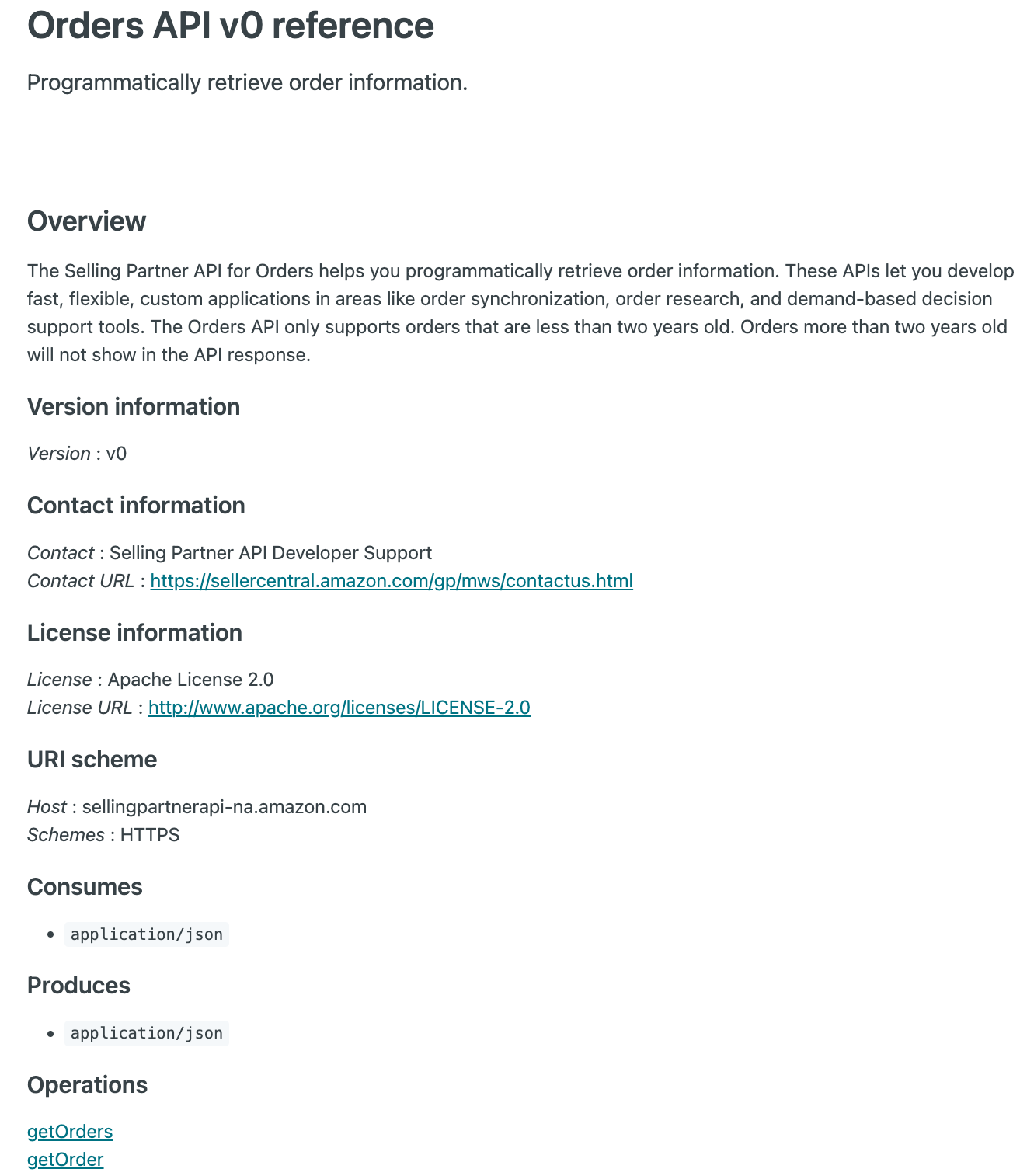
Here, for example, is the description of the “Orders” interface, which provides the following data for your orders:
- Data of a specific order (getOrder)
- Data of multiple orders (getOrders)
- Buyer information for the specified order (getOrderBuyerInfo)
- Delivery address for the specified order (getOrderAddress)
- Detailed information about individual parts of the order (getOrderItems)
In the following table, the endpoints of the MWS API are compared to the endpoints of the new Selling Partner API:
| Name | Function |
|---|---|
| A-Plus Content | Creating and editing A+ content |
| Catalog items | Retrieving item details in the Amazon catalog |
| Product Pricing | Retrieving product prices and offer information |
| Shipping | Retrieving shipping services |
| Amazon MWS | Selling Partner API |
| Feeds | Feeds-API |
| Finances | Finances-API |
| Fulfillment Inbound Shipment | Fulfillment Inbound API |
| Fulfillment Outbound Shipment | Fulfillment Outbound API |
| Merchant Fulfillment | Merchant Fulfillment API |
| Orders | Orders API |
| Product Fees | Product Fees API |
| Product Listing | Catalog Items API |
| Product Pricing | Pricing API |
| Recommendations | Deprecated in SP-API |
| Reports | Report API |
| Sellers | Sellers API |
| Subscriptions | Notifications API |
Even if you’re not a developer, getting an overview of the possible automation is valuable. The implementation itself can be left to experienced developers.
The documentation developers can use to create applications includes API references, guides for application examples, and additional resources.
Amazon Vendor API
The introduction of the new Selling Partner API also marked the first time that interfaces were made available for vendors.
Overview of available Vendor APIs:
- Vendor Direct Fulfillment Inventory
- Vendor Direct Fulfillment Orders
- Vendor Direct Fulfillment Payments
- Vendor Direct Fulfillment Shipping
- Vendor Direct Fulfillment Transactions
- Vendor Invoices
- Vendor Orders
- Vendor Shipments
- Vendor Transactions Status
How to Transition from MWS API to SP-API?
Transitioning from the MWS API to the SP API involves several steps, and it’s essential to ensure that you have registered your Amazon MWS application and published it in the Marketplace Appstore before starting the process.
Here’s a guide on how to make the transition:
- Request Data Access: Initiate the data access your SP API application requires. You can locate the necessary data within your developer profile.
- Create and Configure an IAM ARN: Set up and configure an IAM (Identity and Access Management) Amazon Resource Name (ARN).
- Convert Your MWS Application: Transform your Amazon MWS application into a hybrid Selling Partner API application.
- Implement an Authorization Workflow: Design an authorization workflow for your hybrid application.
- Establish a Connection to SP API: Establish a connection to the Selling Partner API, ensuring seamless interaction.
- Publish Your Hybrid Selling Partner Application: Publish your hybrid application on the Marketplace Appstore to make it accessible to users.
- Migrate MWS Authorizations: Transition your existing Amazon MWS authorizations to Selling Partner API authorizations.
- Migrate MWS Calls: Adapt and migrate your Amazon MWS API calls to the Selling Partner API equivalents.
For detailed guidance, refer to the step-by-step migration instructions in the documentation.
How to create your own app?
To create an app, you’ll need a developer profile. Follow these steps in Seller Central:
- Click on “Partner Network” and then select “Develop Apps.”
- You’ll be directed to your developer profile, where you can manage existing apps and add new ones.
- To register a new app, provide the following information:
- App Name: Choose a suitable name for your app.
- App Type: Select the type of app you’re creating.
- Authorization Type: Specify the authorization type required for your app.
- Redirect URL: Provide the URL where users will be redirected after authorization.
- Description: Add a brief description of your app’s functionality.
- Business Use Case: Explain how your app will be used to benefit users.
- Developer Contact Information: Enter contact details for the developer responsible for the app.
- App Logo: Upload a logo for your app (optional).
- Once you’ve filled in the necessary information, submit the registration.
After successfully registering your app, you’ll receive the necessary credentials and information for integrating the app with the Amazon Selling Partner API.
Amazon Advertising API (AA-API)
Amazon offers sellers the opportunity to promote their products on the platform. With the Amazon Advertising API (AA-API), you can programmatically manage campaigns, ad groups, ads, keywords, bids, and budgets. Additionally, you can analyze and actively control the performance of your advertisements. This allows you to automate, scale, and optimize your advertising efforts.
The AA-API enables you to manage campaigns for Sponsored Products, Sponsored Brands, and Sponsored Display. Insights from Amazon Attribution are also accessible.
To get started, you need to apply for access for the first time.
Like the Selling Partner API, the AA-API provides a sandbox environment for development and testing.
The AA-API allows you to develop specific automation for campaigns, such as:
- Automatically adjusting bids based on the current competitive landscape
- Updating campaigns or ad groups
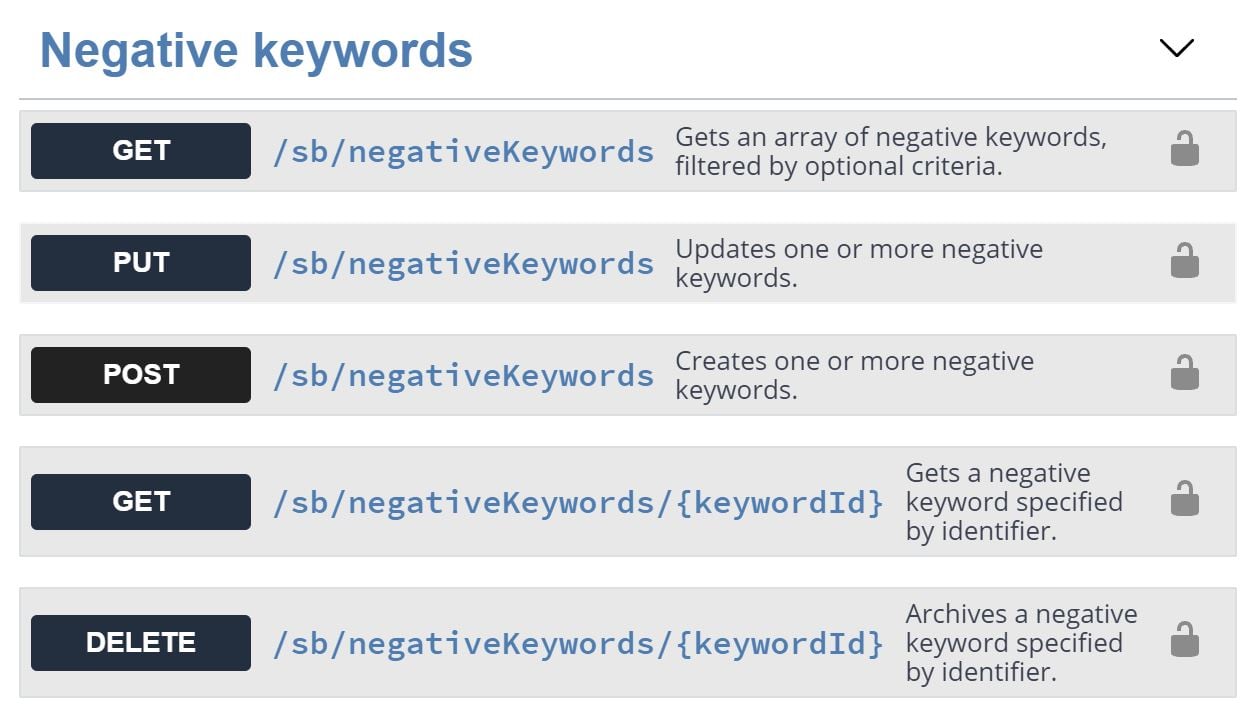
Here, for example, is the description of the Negative Keywords API, which provides data related to negative keywords:
- Retrieve a list of negative keywords with the option to specify criteria (GET)
- Update one or more negative keywords (PUT)
- Create one or more negative keywords (POST)
- Retrieve a negative keyword by ID (GET)
- Set the status of a negative keyword to archived (DELETE)
Using this API incurs no additional charges. You’ll only pay the fees associated with your Seller account and the campaign costs for using Sponsored Products, Sponsored Brands, and Sponsored Display.
You can get an overview of the capabilities in the documentation.
Conclusion
The Selling Partner API empowers sellers on Amazon to programmatically access data related to orders, payments, reports, and more. The Advertising API aids in analyzing and managing your advertisements, giving you direct control over your advertising efforts.
Seller Central is typically sufficient for inventory management for sellers with a smaller inventory. However, Amazon offers additional tools beyond this for sending and receiving data. Integrating an API reduces the need for standardized tasks that are manually intensive. This not only saves you time but also helps prevent errors.
Subscribe to Newsletter
Get the latest Amazon tips and updates delivered to your inbox.
Wir respektieren Ihre Privatsphäre. Jederzeit abbestellbar.
Related Articles
Bulk Operations in Amazon Vendor Central
Learn how to efficiently manage large product catalogs in Amazon Vendor Central using bulk operations. This guide covers the process, benefits, risks, and best practices.

Henriette Rasmussen
Amazon Net PPM Explained
Unlock the secrets of maximizing your profits on Amazon with our expert guide to understanding and improving your Net PPM today!

Trutz Fries
Best Amazon Podcasts: Enhance Your Amazon knowledge
Discover top Amazon podcasts to boost your Amazon knowledge.

Trutz Fries